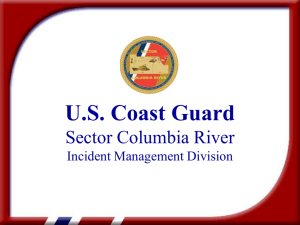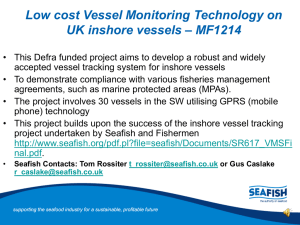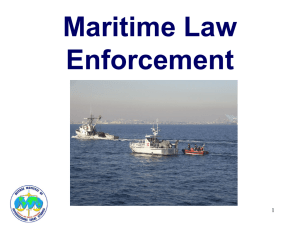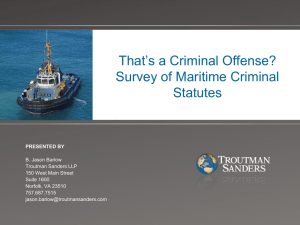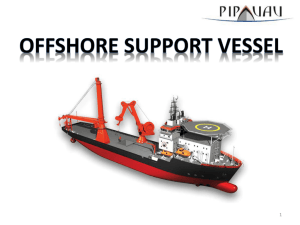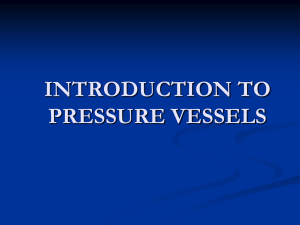Australia`s maritime jurisdiction
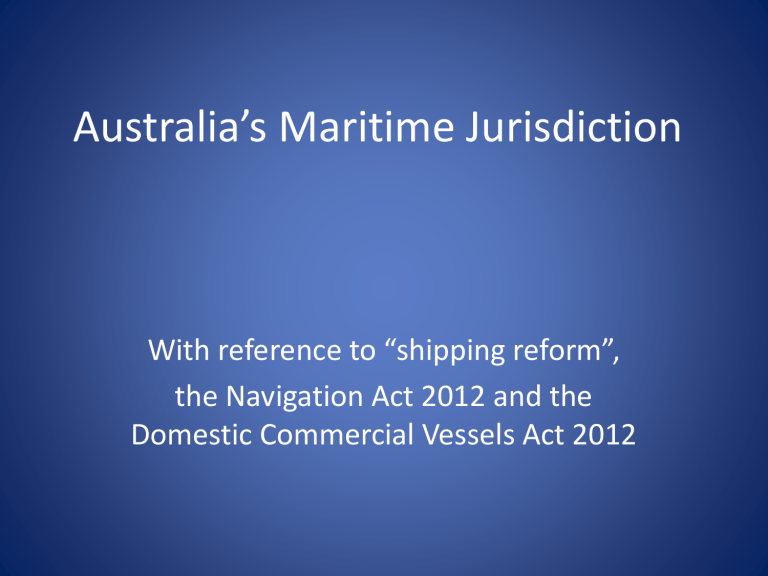
Australia’s Maritime Jurisdiction
With reference to “shipping reform”, the Navigation Act 2012 and the
Domestic Commercial Vessels Act 2012
Australia’s Maritime Jurisdiction
•
Old system:
– Navigation Act 1912 all interstate vessels fully covered, international vessels covered in some respects (IMO Conventions), seafarer provisions including STCW Qualifications, coastal trading and other matters – salvage, wrecks etc.
– State laws applied in ports, harbours and rivers etc. as well as intra-State voyaging
Australia’s Maritime Jurisdiction
•
New system:
– Navigation Act 2012 only covers international ships [and ships which opt in with SOLAS compliance etc];
– Marine Safety (Domestic Commercial Vessels)
National Law 2012 covers all interstate and intrastate vessels regarding safety matters;
– Coastal Trading (Revitalising Australian Shipping)
Act 2012 applies to interstate trading vessels in relation to commercial matters
Australia’s Maritime Jurisdiction
Shrinking fast – the Australian flag fleet
1962 Robert Menzies PM – 148 trading vessels – 138 were Australian flag vessels
1979 Malcolm Fraser PM – 112 trading vessels, 93 were Australian flag vessels
1987 Bob Hawke PM – 96 trading vessels, 89 were Australian flag vessels
2002 John Howard PM – 90 trading vessels, 54 were Australian flag vessels
2008 Kevin Rudd PM - 45 trading vessels, just 30 were Australian flag vessels
2011 Julia Gillard PM – 36 trading vessels, just 22 were Australian flag vessels
2013 Kevin Rudd PM - 35 trading vessels, just 18 are Australian flag vessels
2013 Tony Abbott PM – 33 trading vessels, just 16 are Australian flag vessels
Australia’s Maritime Jurisdiction
• Consequences for tug sector:
• Old system:
– Nav Act 1912 only applied on interstate voyages;
– Tugs either State or Federal registration at owners discretion;
– Engineers qualifications either State or Federal depending on level of qual (& size of tug);
– Generally State or Territory navigation law applied;
– Generally State or Territory workers comp;
– Generally state or Territory OHS;
Australia’s Maritime Jurisdiction
•
Consequences for tug sector:
•
New system:
– MS (DCV) Act applies at all times [except international delivery voyages?];
– Tugs either State or Federal registration;
– Engineer quals covered by MS(DCV) Act;
– Generally State or Territory workers comp;
– Generally state or Territory OHS;
Australia’s Maritime Jurisdiction
•
Major consequence:
– MO3 not applicable to personnel on vessels covered by MS(DCV).
– M505 is applicable – ‘son of NSCV Part D’;
– Engineer Class 3, MED 1, MED 2 and MED 3
AIMPE Solution:
Marine Engineers Qualifications Bill.
Australia’s Maritime Jurisdiction
•
domestic commercial vessel means a vessel that is for use in connection with a commercial, governmental or research activity.
Australia’s Maritime Jurisdiction
• a vessel is not a domestic commercial vessel if the vessel:
• (a) is a regulated Australian vessel; or
• (b) is a foreign vessel; or
• (c) is a defence vessel; or
• (d) is owned by:
• (i) a primary or secondary school; or
• (ii) a community group of a kind prescribed by the regulations.
Australia’s Maritime Jurisdiction
• 19 Duty of crew of domestic commercial vessels to take reasonable care for safety of persons, etc.
•
•
•
•
•
•
•
(1) A member of the crew of a domestic commercial vessel, when carrying out duties as a member of the crew, must:
(a) take reasonable care for his or her own safety; and
(b) take reasonable care for the safety of persons who may be affected by his or her acts or omissions; and
(c) a supervisor.
comply with any reasonable and lawful directions of the master of the vessel or
(2) A member of the crew of a domestic commercial vessel must not interfere with or misuse anything provided on the vessel in the interests of the safety of the vessel.
(3) A member of the crew of a domestic commercial vessel must not unreasonably place the safety of another person at risk when carrying out duties as a member of the crew.
(4) Without limiting subsection (1), a member of the crew of a domestic commercial vessel contravenes that subsection if the member of the crew prevents or restricts the master of the vessel from making or implementing a decision that, in the professional opinion of the master, is necessary for the safety of a person or the vessel.
Australia’s Maritime Jurisdiction
•
•
•
•
•
•
•
•
•
•
•
•
•
•
•
• 5 Constitutional reach of Act
(1)
(a)
(b)
(c)
(d)
(e)
(f)
(g)
This Act applies to activities of, or matters that relate to, the following: a vessel engaged in trade and commerce:
(i) among the States; or
(ii)
(iii) between a State and a Territory; or between 2 Territories; a vessel that is external to Australia; a vessel of which the owner, or any of the owners, is a constitutional corporation; a vessel, so far as the application of this Act to activities of, or in relation to, the vessel is reasonably appropriate and adapted to giving effect to Australia’s obligations under an international agreement; a vessel of which the owner, or any of the owners, is the Commonwealth or a
Commonwealth authority; a vessel that is within a participating Territory; navigation or shipping, to the extent that the navigation or shipping relates to trade and commerce:
(i)
(ii) among the States; or between a State and a Territory; or
(iii) between 2 Territories;
Australia’s Maritime Jurisdiction
•
•
•
•
•
• (h) any matter that may be made the subject of the jurisdiction of the High Court under paragraph 76(iii) of the Constitution;
(i) things that are incidental to activities or matters referred to in any of the above paragraphs.
(2) For the purposes of subsection (1), an activity of, or a matter in relation to, a vessel includes, but is not limited to, an activity done by a person, or in relation to a person, in the capacity of owner, master or crew of the vessel.
(3) For the purposes of subsection (1), external to Australia means:
(a) beyond the baseline from which the breadth of the territorial sea is measured under section 7 of the Seas and Submerged Lands Act 1973; or
(b) any waters on the landward side of the territorial sea that are not within the limits of a State or internal Territory.
• Note 1:For the baseline see Australia’s territorial sea baseline (AGPS) 1988: generally the baseline is the lowest astronomical tide along the coast but it also includes lines enclosing bays and indentations that are not bays and straight baselines that depart from the coast.
• Note 2:A reference to Australia in any other provision of this Act includes a reference to the coastal sea of Australia: see section 15B of the Acts Interpretation Act 1901.
Australia’s Maritime Jurisdiction
•
6 Relationship with State and Territory laws
•
(1) This Act is intended to apply to the exclusion of a law of a State or Territory that relates to marine safety so far as it would otherwise apply in relation to domestic commercial vessels.
Australia’s Maritime Jurisdiction
•
•
•
•
•
•
•
•
•
•
•
• (2)
•
However, subsection (1) does not apply to a law of a State or Territory so far as:
(a) not apply; or the law is prescribed by the regulations as a law to which that subsection does
(b) the law deals with any of the following matters:
(i)
(ii) management of ports, harbours and moorings; environmental management, including pollution, impact assessments and sanctuaries; pilotage; (iii)
(iv)
(v)
(vi)
(vii)
(viii) management of dangerous goods; designation of waters, including designation of waters by reference to the vessels that are or are not permitted to operate in those waters; regulation or prohibition of the operation of specified vessels or classes of vessels in specified areas; harbour masters;
(ix)
(x) speed limits, navigation aids, traffic management plans, rules for prevention of collisions, no wash zones, the management of events on waterways, wrecks, salvage, passing dredges, towing objects, bar crossings and local knowledge requirements; removing obstructions (including abandoned, sinking and derelict vessels) from navigable waters; the actions of persons under the influence of alcohol or other drugs;
•
•
•
•
•
•
•
•
•
•
•
•
Australia’s Maritime Jurisdiction
(xi)
(xii)
(xiii)
(xiv) false distress signals and calls; management of passengers; repairs, cutting or welding occurring on board vessels; requirements for vessels conducting particular dangerous operations or operations that may cause offence, including hauling garbage; prices charged for the provision of commercial services; (xv)
(xvi)
(xvii) fisheries management; storage, preparation, service and disposal of food and beverages on vessels;
(xviii) marine radio;
(xix)
(xx)
(xxi)
(xxii) monitoring of marine communication services; gas and electrical safety; workplace health and safety; emergency management and response;
(xxiii) any other matters prescribed by the regulations.
Australia’s Maritime Jurisdiction
• Marine Safety (Domestic Commercial Vessels)
Act 2012
• foreign vessel has the same meaning as in the
Navigation Act 2012 of the Commonwealth.
• Navigation Act 2012
• foreign vessel means a vessel:
• (a) that does not have Australian nationality; and
• (b) that is not a recreational vessel.
Australia’s Maritime Jurisdiction
•
•
•
•
•
•
•
• 15 Definition of regulated Australian vessel
(1) A vessel is a regulated Australian vessel if:
(a) under the Shipping Registration Act 1981, the vessel is registered, required to be registered or exempt under section 13 of that Act from that requirement; and
(b)
(c) the vessel is not a recreational vessel; and any of the following apply:
(i) the vessel is proceeding on an overseas voyage or is for use on an overseas voyage;
(ii) a certificate issued under this Act, other than a non-Convention tonnage certificate or a certificate prescribed by the regulations, is in force for the vessel;
(iii) an opt-in declaration is in force for the vessel.
Coastal Trade - declining
Total Exports - climbing
Total imports - climbing
Total international trade
Import Stats – Sydney No. 1
Export stats – Hedland No.1
Ship call stats – Hedland No. 1
Total Ship Calls - Upwards
Membership increasing
Total AIMPE members
4 000
3 500
3 000
2 500
2 000
1 500
1 000
500
0
Years
2004 -
2012
Total AIMPE members
